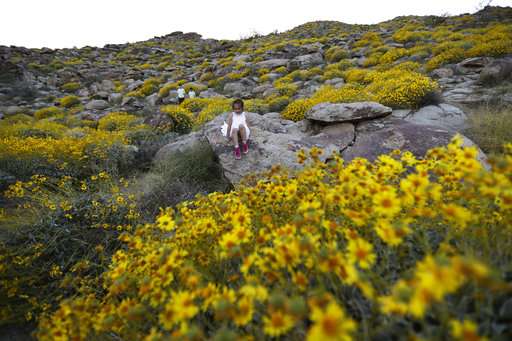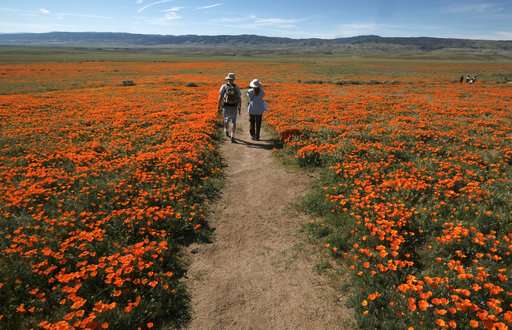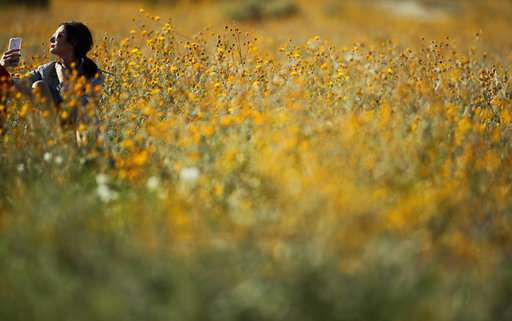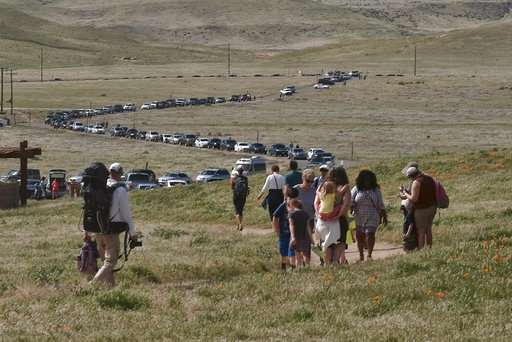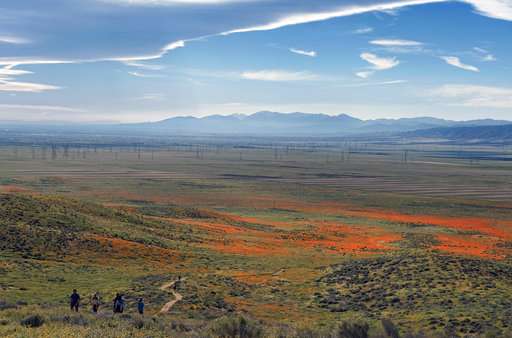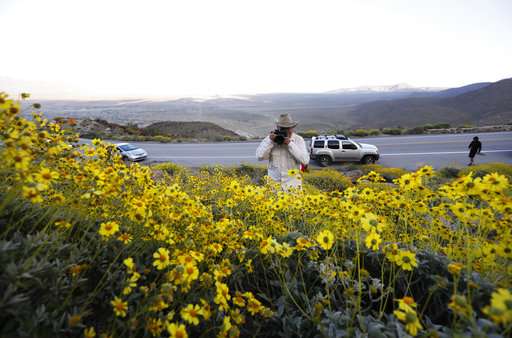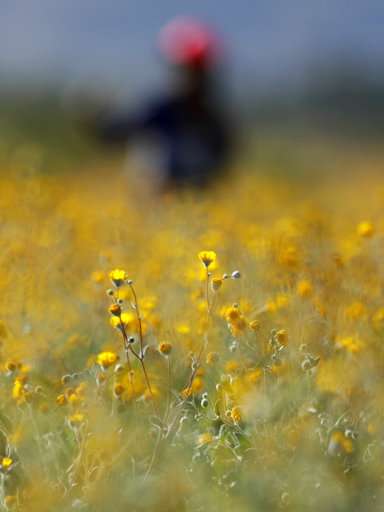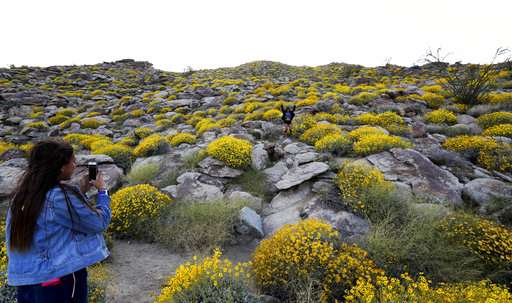In this March 27, 2017, photo, Zoey Speer, of Temecula, Calif., clamors among rocks and blooming desert shrubs in Borrego Springs, Calif. Rain-fed wildflowers have been sprouting from California's desert sands after lying dormant for years - producing a spectacular display that has been drawing record crowds and traffic jams in area desert towns. (AP Photo/Gregory Bull)
An explosion of wildflowers in California's desert sands is drawing record crowds to see the rare abundance of color called a "super bloom."
The natural wonder is thanks to a wet winter followed by warm temperatures in the Anza-Borrego State Park, northeast of San Diego. Wildflower seeds that have been dormant for years in the drought-plagued region have sprouted in mass, producing a spectacular display not seen in 20 years.
An estimated 150,000 people in the past month have converged on Borrego Springs, a town of about 3,500 that abuts the park.
Rain-fed wildflowers are springing up in different landscapes across the state and the western United States. In the Antelope Valley, an arid plateau northeast of Los Angeles, blazing orange poppies are lighting up the ground.
But the "super bloom"—mass amounts of desert plants blooming at once—has been concentrated in the 640,000-acre (1,000-square-mile) Anza-Borrego State Park.
In California, super blooms happen about once in a decade in a given area. They have been occurring less frequently with the drought. Last year, the right amount of rainfall and warm temperatures produced carpets of flowers in Death Valley.
In this March 19, 2017, photo, visitors walk among the poppy bloom at Antelope Valley California Poppy Reserve in Lancaster, Calif. Rain-fed wildflowers have been sprouting from California's desert sands after lying dormant for years - producing a spectacular display that has been drawing record crowds and traffic jams to desert towns. (AP Photo/Richard Vogel)
The natural show at Anza-Borrego is expected to roll along through May, with different species blooming at different elevations and in different areas. The state park is California's largest, with hundreds of species of plants including desert lilies, blazing stars and the flaming tall, spiny Ocotillo.
Deputies were brought in to handle the traffic jams as Borrego Springs saw its population triple in a single day.
On one particularly packed weekend in mid-March, motorists were stuck in traffic for five hours, restaurants ran out of food, and some visitors relieved themselves in the fields. Officials have since set up an army of Port-A-Pottys, and eateries have stocked up. The craze has been dubbed "Flowergeddon."
Tour groups from as far as Japan and Hong Kong have flown in to catch the display before it fades away with the rising temperatures.
In this March 27, 2017, photo, a visitor takes a selfie among wildflowers in Borrego Springs, Calif. Rain-fed wildflowers have been sprouting from California's desert sands after lying dormant for years - producing a spectacular display that has been drawing record crowds and traffic jams in area desert towns. (AP Photo/Gregory Bull)
Wildflower enthusiasts worldwide track the blooms online and arrive for rare sightings like this year's Bigelow's Monkey flower, some of which have grown to 8 inches (203 millimeters) in height. The National Park Service has even pitched in with a 24-hour wildflower hotline to find the best spots at the state park.
"We've seen everything from people in normal hiking attire to people in designer flip-flops to women in sundresses and strappy heels hike out there to get their picture. When I saw that, I thought, 'Oh no. Please don't go out there with those shoes on,'" laughed Linda Haddock, head of the Borrego Springs Chamber of Commerce.
On a recent day, a young woman sat among knee-high desert sunflowers and shot selfies against the backdrop of yellow blooms that looked almost neon in contrast to the brown landscape. A mother jumped in the air as her daughter snapped her photo among yellow brittlebushes.
The blooms are attracting hungry sphinx moth caterpillars that munch through acres. The caterpillars in turn are attracting droves of Swainson hawks on their annual 6,000-mile (9,656-kilometer) migration from Argentina.
In this March 19, 2017, photo, visitors and traffic converge at Antelope Valley California Poppy Reserve in Lancaster, Calif. Rain-fed wildflowers have been sprouting from California's desert sands after lying dormant for years—producing a spectacular display that has been drawing record crowds and traffic jams to desert towns. (AP Photo/Richard Vogel)
"It's an amazing burst in the cycle of life in the desert that has come because of a freakish event like a super bloom," Haddock said. "It's exciting. This is going to be so huge for our economy."
This year's display has been especially stunning, experts say. The region received 6½ inches (165 millimeters) of rain from December to February, followed by almost two weeks of 90-degree temperatures, setting the conditions for the super bloom. Five years of drought made the seeds ready to pop.
Humans also helped. Park staff, volunteers and female prisoners have been removing the Sahara Mustard plant, an invasive species believed brought to California in the 1920s with another plant, the date palm. Sahara Mustard had been covering popular wildflower areas, said Jim Dice, research manager at the Anza-Borrego Desert Research Center.
Sandra Reel and her husband drove hundreds of miles out of their way when they heard about this year's super bloom.
"It is absolutely phenomenal to see this many blooming desert plants all at the same time," she said. "I think it's probably a once-in-a-lifetime thing."
-
In this March 19, 2017, photo, visitors walk among the poppy bloom at Antelope Valley California Poppy Reserve in Lancaster, Calif. Rain-fed wildflowers have been sprouting from California's desert sands after lying dormant for years - producing a spectacular display that has been drawing record crowds and traffic jams to desert towns. (AP Photo/Richard Vogel)
-
In this March 27, 2017, photo, retired California state park ranger Jim Long, of San Clemente, Calif., takes pictures among blooming desert shrubs in Borrego Springs, Calif. Rain-fed wildflowers have been sprouting from California's desert sands after lying dormant for years - producing a spectacular display that has been drawing record crowds and traffic jams in area desert towns. (AP Photo/Gregory Bull)
-
In this March 27, 2017, photo, a visitor poses for a picture among wildflowers blooming in Borrego Springs, Calif. Rain-fed wildflowers have been sprouting from California's desert sands after lying dormant for years - producing a spectacular display that has been drawing record crowds and traffic jams in area desert towns. (AP Photo/Gregory Bull)
-
In this March 27, 2017, photo, Camille Perkins, left, of Dana Point, Calif., takes a picture of her mother, Cynthia Perkins jumping among blooming desert shrubs in Borrego Springs, Calif. Rain-fed wildflowers have been sprouting from California's desert sands after lying dormant for years - producing a spectacular display that has been drawing record crowds and traffic jams in area desert towns. (AP Photo/Gregory Bull)
© 2017 The Associated Press. All rights reserved.
